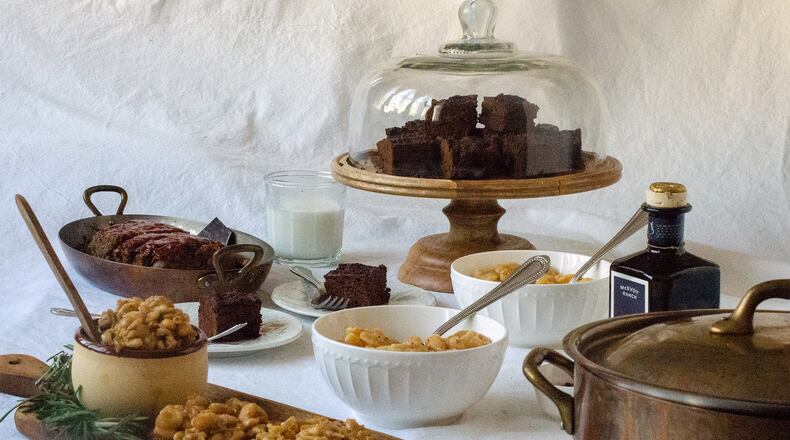Beans are fundamental in many cuisines. Healthy and economical, they are a go-to in kitchens around the world.
France is famous for cassoulet. Latin foodways offer Frijoles Charros (Cowboy Beans), Moros y Cristianos (Black Beans and Rice), and more. There are a multitude of Italian white bean dishes including Fagioli al Fiasco, or beans cooked in a bottle nestled in the embers of a fire, and Ribollita, a hearty bean vegetable stew. Senegalese cooking brings us Ndambe, a spicy, hearty stew featuring black-eyed peas, tomatoes and potatoes.
Beans feed the world — and you can count on beans to be a great resource in your kitchen for budget-minded cooking.
I’ll often cook a pound of dried beans at the beginning of the week and reheat them over the next few days as a warm side dish, toss cold into a salad, or cook further for soup. They’re also a great protein for a healthy breakfast with an egg atop a tortilla.
Knowing how to cook dried beans gives you enormous maneuverability in the kitchen. And having canned beans in your pantry can be a lifesaver at suppertime. Beans are infinitely adaptable, inexpensive and nutritious.
Why are beans so good for you? Beans are seeds that contain the embryo of a future plant, so you get the nutrients the plant would use during its early stages of growth. Beans have been shown to have an important role in preventing illnesses such as cancer, diabetes and heart disease. They are a low-fat source of protein, with high fiber content and a low glycemic index. Beans contain both soluble and insoluble fibers. The former helps to decrease blood cholesterol levels and control blood sugar levels; the latter helps with digestion and gut regularity.
Speaking of gut regularity, you may recall the children’s tune: “Beans, beans, the musical fruit. The more you eat, the more you toot … .” The best way to prevent gassiness is to cook beans until completely cooked and tender.
Another common bean concern is to salt or not to salt. There are advocates on both sides. Some say salt can make the skins tough, especially with older beans, yet America’s Test Kitchen advocates to actually brine beans! I go with the advice of Steve Sando, owner of Rancho Gordo Beans, who suggests salting the beans once the skins start to soften. The primary benefits of cooking with dried beans are that you can control not only the tenderness, but also the sodium content.
Dried beans and canned beans are comparable nutritionally, apart from sodium. Typically, standard canned beans are higher in salt. Both have their pros and cons. Canned beans cost about three times as much as dried ones and vary a lot in texture and flavor from brand to brand. However, for convenience, you can’t beat having a selection of canned beans in your pantry. Dried beans require longer cooking, and some recipes require soaking overnight or a quick soak when you bring beans to a boil and let them soak for one hour.
Cooking beans in a pressure cooker means there is no pre-soaking. It’s simple. One pound of beans plus 6 cups of liquid in an 8-quart Instant Pot takes 15 to 20 minutes to come to full pressure before cooking begins. Then, 30 minutes to cook and 20 minutes to naturally release the pressure.
The recipes here call for a mixture of canned and dried: White Bean Toast, Lima Bean Soup, Lentil Loaf, and Black Bean Brownies. For interchangeability, remember 1 pound of dry edible beans yields about 6 cups of cooked beans and 1 can of beans is about 1 1/2 cups of drained cooked dried beans.
Knowing how to cook beans gives you enormous maneuverability in the kitchen. This handy culinary skill helps with meal prep and gives you the ability to magically produce multiple meals out of a humble bag or can.
Virginia Willis is an Atlanta-based Food Network Kitchen chef, James Beard Award-winning food writer and cookbook author. Follow her at virginiawillis.com.
RECIPES
White Bean Toast, Lima Bean Soup, Lentil Loaf, and Black Bean Brownies are recipes you can count on for nutrition, flavor and affordability.
Credit: Virginia Willis
Credit: Virginia Willis
White Bean Toast
With avocado prices skyrocketing, it’s time to try “Beans on Toast,” a traditional British breakfast for nearly a century. Instead of a savory tomato sauce as with the English version, these canned beans are heated with onions, garlic, rosemary and olive oil. Cannellini, Great Northern and navy beans will all work as high-protein, low-fat toast toppers.
Credit: Virginia Willis
Credit: Virginia Willis
Lima Bean Soup
This comforting soup is old-fashioned country cooking. Miso gives this soup a pop of savory umami, a multicultural twist that replaces a smoky Southern ham hock. Served plain or topped with sauerkraut, it would be at home in grandma’s kitchen. The flavor profile of the intensely vegetal beans is easily changed by tweaking the garnish; drizzled with olive oil and topped with fresh herbs, it has a completely different taste and feel.
Credit: Virginia Willis
Credit: Virginia Willis
Lentil Loaf
No one will miss the meat with this hearty lentil loaf, which is based on an iconic recipe in the 1974 “Moosewood Cookbook” by Mollie Katzen. Be sure to use whole — not split — lentils in this recipe.
Credit: Virginia Willis
Credit: Virginia Willis
Black Bean Brownies
Pureed black beans effectively replace oil or melted butter in this brownie recipe, making the texture slightly more cakey and less dense and fudgy. However, there’s no lack of intense chocolate flavor! Enjoy this rich treat with a glass of cold milk.
Sign up for the AJC Food and Dining Newsletter
Read more stories like this by liking Atlanta Restaurant Scene on Facebook, following @ATLDiningNews on Twitter and @ajcdining on Instagram.
About the Author
The Latest
Featured





